Executive Summary
From the laboratory to the courtroom, the possibilities presented with light microscopy facilitate a range of tasks throughout the area of forensic science. Markus Fabich of Olympus Europa explains.
Over the years, the use of light microscopy has become deeply ingrained within the field of forensic science, and with good reason. A quick and accessible technique, light microscopy is, perhaps most importantly, non-destructive towards precious and irreplaceable samples. Common and routine in nearly every forensic laboratory, specialists unfailingly turn to this approach as a first-line analysis for both research and investigation, before employing subsequent techniques. This is especially important within the latter context, since during a criminal investigation, permission must be granted for destructive testing of a piece of evidence. In some cases sufficient information can be gathered through non-destructive approaches alone. More specialised forms of microscopy are also common, for example polarised light microscopy for fibre identification and comparison microscopy for matching up hair, firearms and tool marks.
At Abertay University in Scotland, the forensic science research team (Dr Kevin Farrugia, Dr Keith Sturrock, Dr Graham Wightman and Isobel Stewart) has employed the latest Olympus opto-digital light microscopy to advance several research projects. As a new category of light microscope combining the latest in optical and digital technologies, opto-digital technology enables fast and detailed inspection and measurement in materials science applications. The Olympus DSX series encompasses investigation, measurement and reporting while intuitive operation means that accurate inspection no longer depends on in-depth microscopy knowledge. Moreover, featuring digital capture and display, on-screen viewing is perfect for comfortable long-term operation, discussions or training. The research team is benefiting from many features of opto-digital microscopy to analyse various types of evidence in greater detail, including fingerprints, illicit drugs and pen marks.
Revealing latent fingerprints
Unique to each individual, the fingerprint left behind on contact with a surface is a vital source of identification. Fingerprints consist of skin ridges that follow a collection of patterns, such as loops, whorls and arches. In addition, each skin ridge holds a row of pores through which sweat is released (Figure 1), and although prints can sometimes be immediately visible if they are made in blood or paint, for example, more often it is the sweat that forms the print. Such latent prints require further treatments for visualisation, depending on the surface on which they were left.
Criminals are often conscious of removing evidence, and one area of research is the recovery of latent prints from metals where the initial residue of the print has been wiped with a cloth. Interestingly, once contact has been made, some of the chemicals in sweat can react with the metal and the fingerprint is effectively etched into the surface, leaving a permanent mark that no amount of wiping will remove. Where there is an attempt to remove the trace of contact with the metal surface, this can also suggest intent to remove evidence. Researchers at Abertay University are looking at ways to visualise these marks through heating the metal above 400ºC, then capturing and analysing images of the mark using the Olympus DSX110. A variety of metals were tested, together with how their removal was affected using different fabrics, including wool, cotton and nylon (Figure 2). Visualising the complete print at higher magnification was important for in-depth analysis, and in all images this was enabled through the image stitching function of the DSX110. Although in some cases the detail generated from these prints may not be sufficient to provide an exact positive identification, they can also be used in conjunction with other information, or to rule out a suspect.
When viewing the prints directly from above, distinguishing the necessary features was challenging. This is where the ability to tilt the head of the DSX110 was found to be of value, allowing the sample to be illuminated and visualised at an angle. Such oblique lighting casts shadows to highlight the surface topography for more detailed visualisation of the valleys etched into the metal (Figure 3).
Fingerprint pores
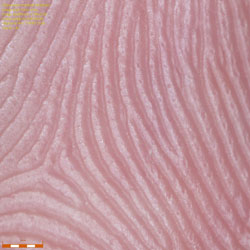 Figure1 | Using the DSX110, fingerprint pores are clearly visible. Pores are responsible for the sweat that forms a print on many surfaces. |
Revealing latent fingerprints from metal.
Fingerprints wiped from metal re-appear following heating to 400°C and above. Using the DSX110, fingerprints were here visualised from copper wiped with wool (A) or nylon (B), and brass wiped with wool (C) or cotton (D). Images courtesy of K Dettori, Abertay University
 Figure2.A: Copper wiped with wool | 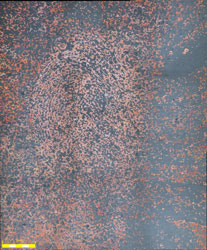 Figure2.B: Copper wiped with nylon |
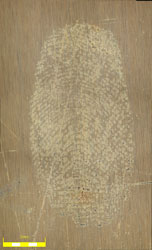 Figure2.C: Brass wiped with wool |  Figure2.D: Brass wiped with cotton |
Highlighting fingerprint patterns on metal with oblique lighting.
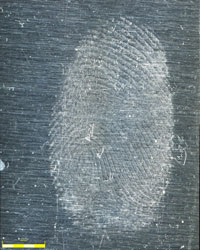 Figure3 | Latent fingerprints made on aluminium and wiped with cotton were heated to 400°C and visualised with light microscopy using the DSX110, with oblique lighting maximising contrast. Image courtesy of K Dettori, Abertay University. |
Logos on seized illicit pharmaceutical tablets
The forensic research group at Abertay University works closely with Police Scotland, who give input to ensure that novel research provides the most impact for front-line forensics applications. As part of this ongoing collaboration, the DSX110 was used to analyse a batch of illicit drugs seized by the police. Drug abuse is a growing issue in itself, but adding to the problem, suppliers commonly replace psycho-active chemicals with alternative substances. Although these are often harmless materials such as sugar they can sometimes be more sinister. Moreover the level of active drug substance present can often vary significantly. For example, whilst some illicit diazepam tablets recently examined were found to contain 10 mg (the dose available from the pharmacist), others were found to contain four times this level, posing a serious risk in terms of overdose. It is therefore vital to try and characterise batches of these tablets for intelligence purposes, and the research group at Abertay University are investigating the possibility of doing this by using a combination of both key physical and chemical characteristics. The hope is that a statistical model can be developed which can identify different populations of tablets within the illegal supply chain and thus assist the police in determining links between different seizures and perhaps even trace certain batches of drugs back to their supplier.
A batch of seized tablets were recently analysed using the Olympus DSX110, with a few case samples shown in Figure 4. Visual characterisation can be achieved based on a number of features, such as colour and design. Many of these tablets contain logos, and some also contain defects on the edges –possibly caused by damage to the machinery for tablet pressing – which could eventually be linked to the batch of drugs. Here again the tilt angle function of the DSX110 was particularly helpful to visualise the logos and the edges in detail (Figure 4B). Digital capability has improved the visualisation of these tablets, with what is known as the Extended Focal Image (EFI) tool. Utilising 3D imaging, EFI compiles a series of 2D images at different points across the z-axis, forming a fully focused composite image across the complete sample, thereby allowing the complete surface of the tablet to be viewed in detail.
Characterising seized drugs.
In-depth profiling of seized drugs assists the police in tracking them back to the supplier. True colour information facilitates this from above (A), in addition to more detailed visualisation highlighting the logo designs and edges of the tablets with the DSX110 tilt angle function (B). Images courtesy of S Greenfield, Abertay University
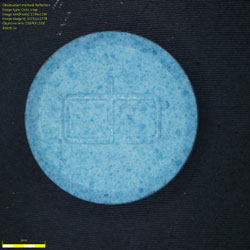 Figure4.A-1 | 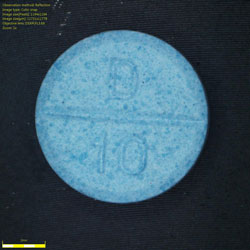 Figure4.A-2 |
 Figure4.A-3 | 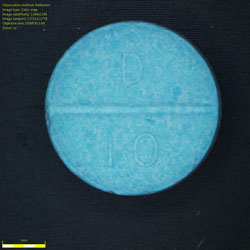 Figure4.A-4 |
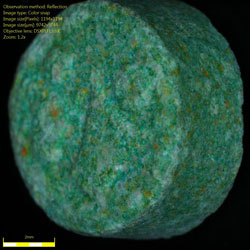 Figure4.B-1 | 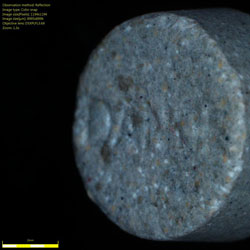 Figure4.B-2 |
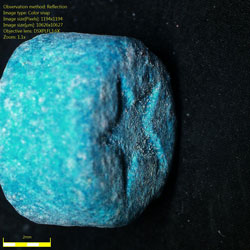 Figure4.B-3 |
Pen marks on paper
Documents may be fraudulently manipulated or forged for a number of reasons. Identity theft and benefit fraud are common, or a murderer may have created a fake suicide note for his victim. The primary aim of any analytical process is to gain as much information as possible without damaging or altering the document, and this is where the non-destructive nature of light microscopy comes into play. Analysis of such documents often involves looking at handwriting, ink and paper, and one project at Abertay looks at discriminating ball point pen mark indentations on paper. When a line is drawn on paper, the pointed tip of the pen distorts the fibres of the paper, leaving an indentation. The morphology of the indentation can vary depending on the user's style of writing, as well as the pen, quality of paper and how soft or hard the underlying substrate is. Alternative methods can also be used alongside light microscopy to provide complementary information, such as the chemical composition of ink. However, chromatography is limited with gel pen inks, which are polymer inks and therefore difficult to dissolve, requiring an alternative means of analysis.
The magnifications achieved using the opto-digital microscope allowed visualisation of the actual fibres of the paper at the same time retaining the colour range and distribution of ink. The indentation depth could also be measured, visualised in the form of a height map that can be viewed and analysed in either 2D or 3D (Figure 5).
Analysing pen indentations on paper.
Distinguishing pen indentations on paper can provide insights into the possible identity of the author. Pen marks have here been visualised with the DSX110 in brightfield (A), 2D imaging based on a height map (B), and 3D imaging based on a height map(C). Images courtesy of K Denovan, Abertay University.
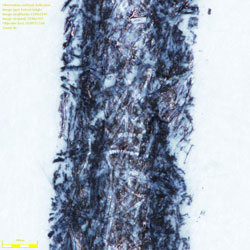 Figure5.A | 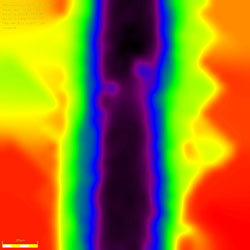 Figure5.B |
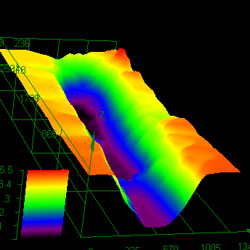 Figure5.C |
In the courtroom
The insights gained through microscopy are invaluable to forensic science, but equally crucial is how such evidence is presented to the courtroom. A picture paints a thousand words, and information in an image can be much more easily explained to a jury, rather than through a numerical or a verbal explanation. Figure 6 shows an example of how data can be clearly communicated with the reporting functions of the DSX110. Furthermore, in all three projects described, one key function was integral to image analysis: the image stitching function. Whether studying a fingerprint, an illicit drug logo or an extended pen mark on a questioned document, creating and presenting large images is vital for communicating evidence to a jury. Presenting the evidence in context, these images can also be zoomed in retrospectively to pick out even the finest details of the sample and yield much greater insight.
Data reporting is vital for courtroom presentation.
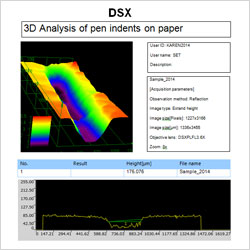 Figure6 | The 3D profile and analysis of a pen indent on paper is reported here alongside additional information such as capture settings. Images courtesy of K Denovan, Abertay University |
Summary
Light microscopy presents many possibilities for use within forensic research and investigations. The design of modern microscopes is increasingly influenced by digital technology, which greatly enhances the resolution and analysis capabilities of systems such as the Olympus opto-digital range. Employing the Olympus DSX110 opto-digital system, the forensic research group at Abertay University has benefited from many of these advanced capabilities to yield greater insights into a variety of forensic samples.
Providing a complementary approach alongside other techniques, light microscopy enables the investigator to reach a decision faster, with less effort and in a non-destructive manner. This is especially important in light of forensic facilities budgetary constraints, where efficiency becomes increasingly valued. With the speed and accessibility of light microscopy, it remains clear that as this technique evolves, it will continue to enhance forensics applications, from research to applied investigations – and even in the courtroom.

